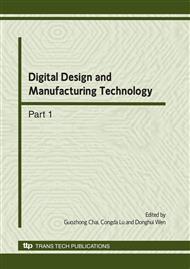[1]
Lee.W. -Sh., Lin. Ch-F, High-temperature deformation behaviour of Ti6Al4V alloy evaluated by high strain-rate compression tests, Journal of Materials Processing Technology, Vol. 75. n3(1998), pp.127-136.
DOI: 10.1016/s0924-0136(97)00302-6
Google Scholar
[2]
R. Ding, Z.X. Guo, A. Wilson, Microstructural evolution of a Ti-6Al-4V alloy during thermomechanical processing, Materials Science and Engineering A, Vol. 327. n2(2002), pp.233-245.
DOI: 10.1016/s0921-5093(01)01531-3
Google Scholar
[3]
XU Wen-chen, SHAH De-bin,YANG Guo-ping, Lv Yan, Flow behavior and microstructure evolution during hot compression of TA 15 titanium alloy, Trans. Nonferrous Met. Soc. China, Vol. 16. s3(2006), p.2066-(2071).
Google Scholar
[4]
Akhtar S. Khan, Rehan Kazmi, Babak Farrokh, Multiaxial and non-proportional loading responses, anisotropy and modeling of Ti-6Al-4V titanium alloy over wide ranges of strain rates and temperatures, International Journal of Plasticity, Vol. 23. n6(2007).
DOI: 10.1016/j.ijplas.2006.08.006
Google Scholar
[5]
N.G. Jones, R.J. Dashwood, D. Dye, M. Jackson, Thermomechanical processing of Ti-5Al-5Mo-5V-3Cr, Materials Science and Engineering A, Vol. 490. n1(2008), pp.369-377.
DOI: 10.1016/j.msea.2008.01.055
Google Scholar
[6]
L.X. Li, K.P. Rao, Y. Lou, D.S. Peng, A study on hot extrusion of Ti-6Al-4V using simulations and experiments, International Journal of Mechanical Sciences, Vol. 44. n12(2002), pp.2415-2425.
DOI: 10.1016/s0020-7403(02)00173-x
Google Scholar
[7]
Xiaoli Li, Miaoquan Li, FE simulation for the forging process of TC6 alloy disc utilizing a microstructural model, Materials Characterization, Vol. 55. n5(2005), pp.362-370.
DOI: 10.1016/j.matchar.2005.07.010
Google Scholar
[8]
P. Vo, M. Jahazi, S. Yue, P. Bocher, Flow stress prediction during hot working of near-α titanium alloys, Materials Science and Engineering A, Vol. 447. n2(2007), pp.99-110.
DOI: 10.1016/j.msea.2006.10.032
Google Scholar
[9]
A. Majorell, S. Srivatsa, R.C. Picu, Mechanical behavior of Ti-6Al-4V at high and moderate temperatures-Part I: Experimental results, Materials Science and Engineering A, Vol. 326. n2(2002), pp.297-305.
DOI: 10.1016/s0921-5093(01)01507-6
Google Scholar
[10]
S. Bruschi, S. Poggio, F. Quadrini, M.E. Tata, Workability of Ti-6Al-4V alloy at high temperatures and strain rates, Materials letters, Vol. 58. n28(2004), pp.3622-3629.
DOI: 10.1016/j.matlet.2004.06.058
Google Scholar
[11]
N.S. Reddy, You Hwan Lee, Chan Hee Park, Chong Soo Lee, Prediction of flow stress in Ti-6Al-4V alloy with an equiaxed α+β microstructure by artificial neural networks, Materials Science and Engineering A, Vol. 492. n2(2008), pp.276-282.
DOI: 10.1016/j.msea.2008.03.030
Google Scholar


